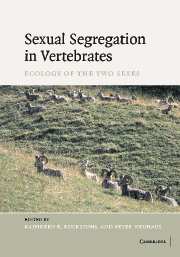Book contents
- Frontmatter
- Contents
- List of contributors
- Preface
- Part I Overview
- Part II Concepts and methodology
- Part III Foraging ecology
- Part IV Predator avoidance and reproductive strategies
- 7 Predation risk as a driving factor for size assortative shoaling and its implications for sexual segregation in fish
- 8 Differences in habitat selection and reproductive strategies of male and female sharks
- 9 Sex differences in reproductive strategies affect habitat choice in ungulates
- Part V Sex-related activities and social factors
- Part VI Sexual differences in ecology: comparisons within different taxa
- Part VII Implications for conservation
- Part VIII Outlook
- References
- Index
9 - Sex differences in reproductive strategies affect habitat choice in ungulates
Published online by Cambridge University Press: 04 September 2009
- Frontmatter
- Contents
- List of contributors
- Preface
- Part I Overview
- Part II Concepts and methodology
- Part III Foraging ecology
- Part IV Predator avoidance and reproductive strategies
- 7 Predation risk as a driving factor for size assortative shoaling and its implications for sexual segregation in fish
- 8 Differences in habitat selection and reproductive strategies of male and female sharks
- 9 Sex differences in reproductive strategies affect habitat choice in ungulates
- Part V Sex-related activities and social factors
- Part VI Sexual differences in ecology: comparisons within different taxa
- Part VII Implications for conservation
- Part VIII Outlook
- References
- Index
Summary
OVERVIEW
Behaviour patterns governing habitat use, predator avoidance and foraging effort ultimately influence the reproductive success and survival of individual animals. Seasonal energy demands, the distribution of food and water, climatic factors, security constraints, physiological mechanisms, breeding patterns and social structure are all expected to influence behaviour patterns in different ways at different times of the year. Furthermore, such variables are interactive, and their effects may vary by age and sex class (Clutton-Brock, 1988).
In polygynous ungulates, reproductive roles differ between males and females as do the behaviour patterns that promote reproductive success. Females select habitats and compete for resources that promote offspring growth and survival, whereas males select habitats that maximize pre-rut energy reserves and promote successful competition with other males for mates (Clutton-Brock et al., 1982; Main & Coblentz, 1990, 1996; Main et al., 1996; Trivers, 1972). Sex differences in behaviours and habitat use that influence reproductive success may, therefore, be viewed as outcomes of sex differences in reproductive strategies. Furthermore, behaviours that influence reproductive success are not limited to periodic mating opportunities, but occur throughout the year for both sexes in different ways via effects on offspring survival or the accumulation of energy reserves important to future reproductive efforts. Consequently, patterns of behaviour and habitat selection exhibited by males and females are expected to differ during different times of the year and reproductive cycle.
- Type
- Chapter
- Information
- Sexual Segregation in Vertebrates , pp. 148 - 162Publisher: Cambridge University PressPrint publication year: 2006
- 5
- Cited by



